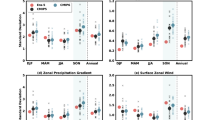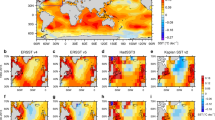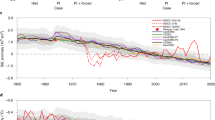Abstract
Global mean sea surface temperature (SST) has risen steadily over the past century1,2, but the overall pattern contains extensive and often uncertain spatial variations, with potentially important effects on regional precipitation3,4. Observations suggest a slowdown of the zonal atmospheric overturning circulation above the tropical Pacific Ocean (the Walker circulation) over the twentieth century1,5. Although this change has been attributed to a muted hydrological cycle forced by global warming5,6, the effect of SST warming patterns has not been explored and quantified1,7,8. Here we perform experiments using an atmospheric model, and find that SST warming patterns are the main cause of the weakened Walker circulation over the past six decades (1950–2009). The SST trend reconstructed from bucket-sampled SST and night-time marine surface air temperature features a reduced zonal gradient in the tropical Indo-Pacific Ocean, a change consistent with subsurface temperature observations8. Model experiments with this trend pattern robustly simulate the observed changes, including the Walker circulation slowdown and the eastward shift of atmospheric convection from the Indonesian maritime continent to the central tropical Pacific. Our results cannot establish whether the observed changes are due to natural variability or anthropogenic global warming, but they do show that the observed slowdown in the Walker circulation is presumably driven by oceanic rather than atmospheric processes.
This is a preview of subscription content, access via your institution
Access options
Subscribe to this journal
Receive 51 print issues and online access
$199.00 per year
only $3.90 per issue
Buy this article
- Purchase on Springer Link
- Instant access to full article PDF
Prices may be subject to local taxes which are calculated during checkout




Similar content being viewed by others
References
Deser, C., Phillips, A. S. & Alexander, M. A. Twentieth century tropical sea surface temperature trends revisited. Geophys. Res. Lett.. 37, L10701, http://dx.doi.org/10.1029/2010GL043321 (2010)
Kennedy, J. J., Rayner, N. A., Smith, R. O., Parker, D. E. & Saunby, M. Reassessing biases and other uncertainties in sea surface temperature observations measured in situ since 1850: 2. Biases and homogenization. J. Geophys. Res.. 116, D14104, http://dx.doi.org/10.1029/2010JD015220 (2011)
Xie, S.-P. et al. Global warming pattern formation: sea surface temperature and rainfall. J. Clim. 23, 966–986 (2010)
Shin, S. I. & Sardeshmukh, P. D. Critical influence of the pattern of tropical ocean warming on remote climate trends. Clim. Dyn. 36, 1577–1591 (2011)
Vecchi, G. A. et al. Weakening of tropical Pacific atmospheric circulation due to anthropogenic forcing. Nature 441, 73–76 (2006)
Held, I. M. & Soden, B. J. Robust responses of the hydrological cycle to global warming. J. Clim. 19, 5686–5699 (2006)
Vecchi, G. A. & Soden, B. J. Global warming and the weakening of the tropical circulation. J. Clim. 20, 4316–4340 (2007)
Tokinaga, H. et al. Regional patterns of tropical Indo-Pacific climate change: evidence of the Walker circulation weakening. J. Clim. 25, 1689–1710 (2012)
Power, S. B. & Kociuba, G. What caused the observed twentieth-century weakening of the Walker circulation? J. Clim. 24, 6501–6514 (2011)
DiNezio, P., Clement, A. & Vecchi, G. A. Reconciling differing views of tropical Pacific climate change. Eos 91, 141–142 (2010)
Clement, A., DiNezio, P. & Deser, C. Rethinking the ocean’s role in the Southern Oscillation. J. Clim. 24, 4056–4072 (2011)
Meng, Q. et al. Twentieth century Walker circulation change: data analysis and model experiments. Clim. Dyn. 38, 1757–1773 (2012)
Meehl, G. A. et al. in Climate Change 2007: The Physical Science Basis (eds Solomon, S. et al.). 747–845 (Cambridge Univ. Press, 2007)
Bunge, L. & Clarke, A. J. A verified estimation of the El Niño index Niño-3.4 since 1877. J. Clim. 22, 3979–3992 (2009)
Rayner, N. A. et al. Global analyses of sea surface temperature, sea ice, and night marine air temperature since the late nineteenth century. J. Geophys. Res.. 108, 4407, http://dx.doi.org/10.1029/2002JD002670 (2003)
Smith, T. M., Reynolds, R. W., Peterson, T. C. & Lawrimore, J. Improvements to NOAA’s historical merged land-ocean surface temperature analysis (1880–2006). J. Clim. 21, 2283–2296 (2008)
Woodruff, S. D. et al. ICOADS Release 2.5: extensions and enhancements to the surface marine meteorological archive. Int. J. Climatol. 31, 951–967 (2011)
Kalnay, E. et al. The NCEP/NCAR 40-year reanalysis project. Bull. Am. Meteorol. Soc. 77, 437–471 (1996)
Uppala, S. M. et al. The ERA-40 re-analysis. Q. J. R. Meteorol. Soc. 131, 2961–3012 (2005)
Compo, G. P. et al. The twentieth century reanalysis project. Q. J. R. Meteorol. Soc. 137, 1–28 (2011)
Johnson, N. C. & Xie, S. -P. Changes in the sea surface temperature threshold for tropical convection. Nature Geosci. 3, 842–845 (2010)
Kennedy, J. J., Rayner, N. A., Smith, R. O., Parker, D. E. & Saunby, M. Reassessing biases and other uncertainties in sea surface temperature observations measured in situ since 1850: 1. Measurement and sampling uncertainties. J. Geophys. Res.. 116, D14103, http://dx.doi.org/10.1029/2010JD015218 (2011)
Deser, C. & Phillips, A. S. Simulation of the 1976/77 climate transition over the North Pacific: sensitivity to tropical forcing. J. Clim. 19, 6170–6180 (2006)
Meehl, G. A., Hu, A. X. & Santer, B. D. The mid-1970s climate shift in the Pacific and the relative roles of forced versus inherent decadal variability. J. Clim. 22, 780–792 (2009)
Ramanathan, V. et al. Atmospheric brown clouds: impacts on South Asian climate and hydrological cycle. Proc. Natl Acad. Sci. USA 102, 5326–5333 (2005)
Xie, S.-P. et al. Decadal shift in El Niño influences on Indo-western Pacific and East Asian climate in the 1970s. J. Clim. 23, 3352–3368 (2010)
The GFDL Global Atmospheric Model Development Team. The new GFDL global atmosphere and land model AM2–LM2: evaluation with prescribed SST simulations. J. Clim. 17, 4641–4673 (2004)
Roeckner, E. et al. The Atmospheric General Circulation Model ECHAM5. Part I: Model Description (MPI report 349, Max Planck Institute, 2003); available at http://www.mpimet.mpg.de/fileadmin/publikationen/Reports/max_scirep_349.pdf (2003)
Collins, W. D. et al. The formulation and atmospheric simulation of the Community Atmosphere Model version 3 (CAM3). J. Clim. 19, 2144–2161 (2006)
Neale, R. B. et al. The mean climate of the Community Atmosphere Model (CAM4) in forced SST and fully coupled experiments. J. Clim. (submitted)
Allan, R. & Ansell, T. A new globally complete monthly historical gridded mean sea level pressure dataset (HadSLP2): 1850-2004. J. Clim. 19, 5816–5842 (2006)
Tokinaga, H. & Xie, S.-P. Wave- and anemometer-based sea surface wind (WASWind) for climate change analysis. J. Clim. 24, 267–285 (2011)
Chen, M. Y., Xie, P. P., Janowiak, J. E. & Arkin, P. A. Global land precipitation: a 50-yr monthly analysis based on gauge observations. J. Hydrometeorol. 3, 249–266 (2002)
Schneider, U., Fuchs, T., Meyer-Christoffer, A. & Rudolf, B. Global Precipitation Analysis Products of the GPCC (Global Precipitation Climatology Centre, 2008); available at ftp://ftp-anon.dwd.de/pub/data/gpcc/PDF/GPCC_intro_products_2008.pdf (2008)
Willmott, C. J. & Robeson, S. M. Climatologically aided interpolation (CAI) of terrestrial air temperature. Int. J. Climatol. 15, 221–229 (1995)
Hulme, M., Osborn, T. J. & Johns, T. C. Precipitation sensitivity to global warming: comparison of observations with HadCM2 simulations. Geophys. Res. Lett. 25, 3379–3382 (1998)
Sen, P. K. Estimates of the regression coefficient based on Kendall’s tau. J. Am. Stat. Assoc. 63, 1379–1389 (1968)
Kendall, M. G. Rank Correlation Methods (Griffin, 1975)
Acknowledgements
We thank A. Timmermann for discussions, and X. T. Zheng and J. Ma for data processing. The work was supported by JAMSTEC, the National Basic Research Program of China (2012CB955600), NASA, NSF and NOAA. NCAR is sponsored by NSF.
Author information
Authors and Affiliations
Contributions
H.T., Y.K. and Y.M.O. designed and performed model experiments. S.-P.X. and C.D. supervised the work. H.T. analysed observations and model simulations. H.T., S.-P.X., C.D. and Y.M.O. wrote the manuscript, with feedback from all authors.
Corresponding authors
Ethics declarations
Competing interests
The authors declare no competing financial interests.
Supplementary information
Supplementary Information
This file contains Supplementary Text 1-4, Supplementary Figures 1-5 and additional references. (PDF 889 kb)
Rights and permissions
About this article
Cite this article
Tokinaga, H., Xie, SP., Deser, C. et al. Slowdown of the Walker circulation driven by tropical Indo-Pacific warming. Nature 491, 439–443 (2012). https://doi.org/10.1038/nature11576
Received:
Accepted:
Published:
Issue Date:
DOI: https://doi.org/10.1038/nature11576
This article is cited by
-
Seasonally varying SST changes in the joining area of Asia and Indian-Pacific Ocean from boreal spring to summer
Climate Dynamics (2024)
-
Attributing interdecadal variations of southern tropical Indian Ocean dipole mode to rhythms of Bjerknes feedback intensity
Climate Dynamics (2024)
-
The weakening of the tropical circulation is caused by the lifting of the tropopause height
Climate Dynamics (2024)
-
Strengthening atmospheric circulation and trade winds slowed tropical Pacific surface warming
Communications Earth & Environment (2023)
-
Increase in ocean-onto-land droughts and their drivers under anthropogenic climate change
npj Climate and Atmospheric Science (2023)
Comments
By submitting a comment you agree to abide by our Terms and Community Guidelines. If you find something abusive or that does not comply with our terms or guidelines please flag it as inappropriate.



